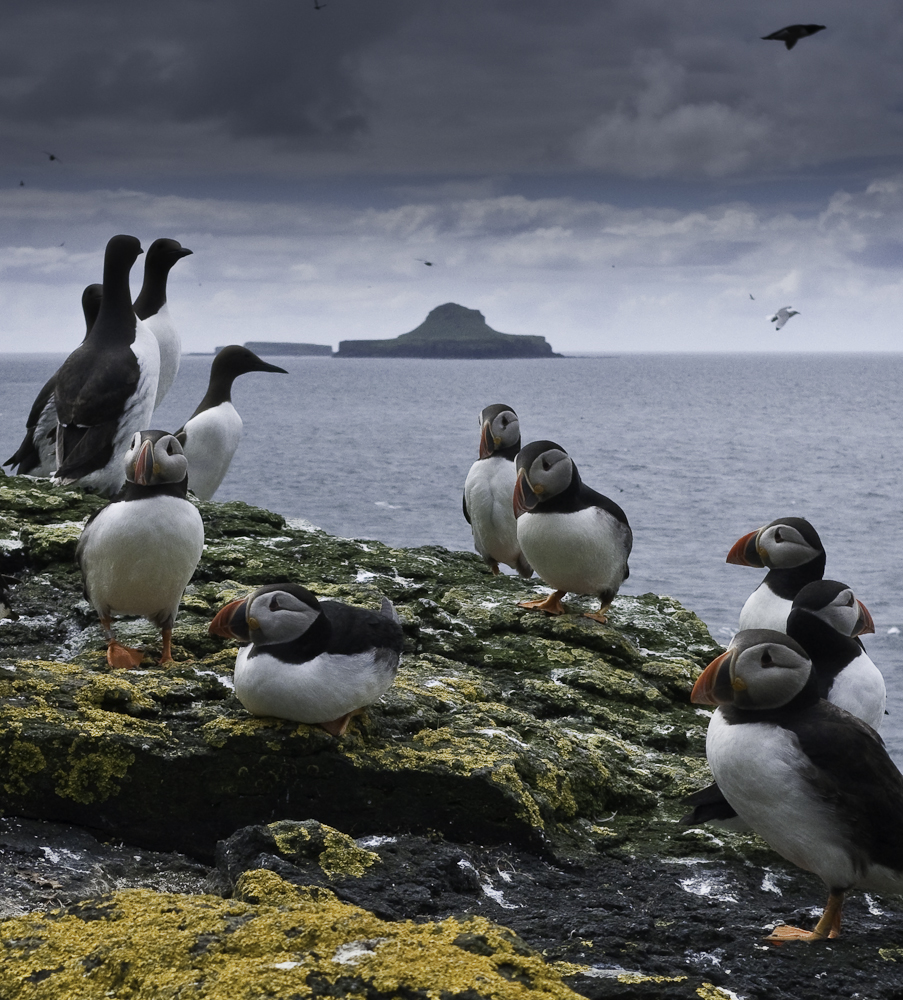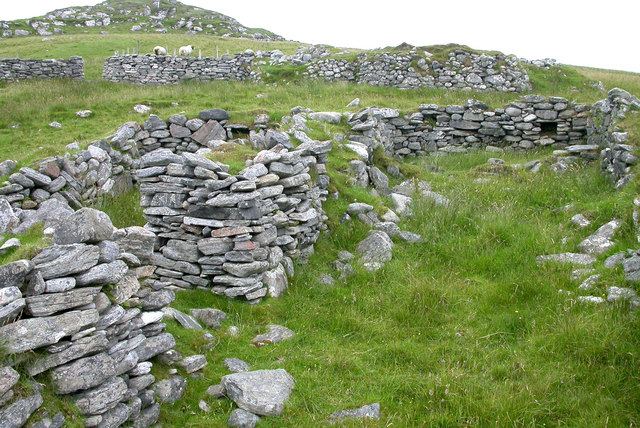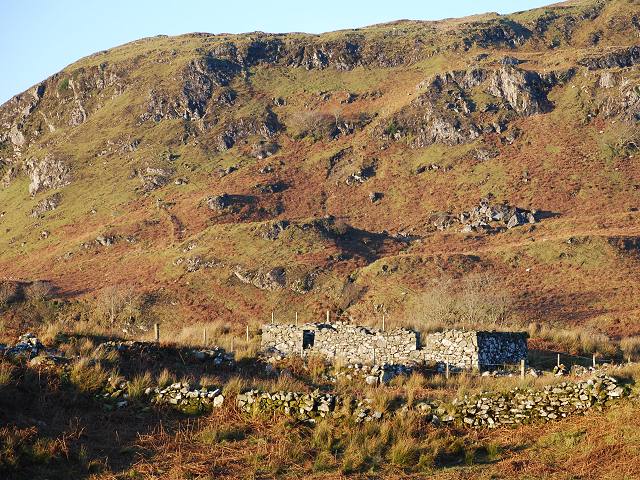|
Bac Mòr
Bac Mòr is a Scottish island, one of the Treshnish Isles, sometimes referred to as The Dutchman's Cap in English because of its shape. Origin of name The Gaelic name has more than one possible interpretation. Although ''Mòr'' clearly means "large" (as opposed to Bac Beag, its smaller sister), the word ''Bac'' can mean either a "bank", or an "obstacle" or "hindrance". The island's profile is one of the more distinctive amongst the Scottish Islands. Geology Bac Mòr is of ancient volcanic origin, and the peak in the middle is a former cone. The low-lying plain surrounding it is a glassy lava field. The remains of summer sheilings have been found on the island, suggesting that it was inhabited at one time, even though it has no safe landing places. Wildlife The Treshnish Isles, which are uninhabited today, are owned by a charity, the Hebridean Trust. They have been collectively designated as a Site of Special Scientific Interest and a Special Protection Area A Special Prote ... [...More Info...] [...Related Items...] OR: [Wikipedia] [Google] [Baidu] |
Treshnish Isles
The Treshnish Isles are an archipelago of small islands and skerries, lying west of the Isle of Mull, in Scotland. They are part of the Inner Hebrides. Trips to the Treshnish Isles operate from Ulva Ferry, Tobermory, Ardnamurchan and Tiree. Geography The archipelago extends over a distance of roughly , from the island of in the south (towards ) to the north-east. The largest island in the group, Lunga, is west of Gometra, south-west of (on the Isle of Mull), south-east of Coll, and north-west of Staffa.Ordnance Survey Landranger Map (1:50 000) "Iona & West Mull". Sheet 48 Other relatively large islands in the group are , Fladda and . There are numerous small skerries, particularly north of Lunga. All the islands are of volcanic origin. History There are several possible duns on the islands of Iron Age origin. Little is known of the early history, although these prominent landmarks would have been significant waypoints for the Norse settlers during their conquest in th ... [...More Info...] [...Related Items...] OR: [Wikipedia] [Google] [Baidu] |
Argyll And Bute
Argyll and Bute ( sco, Argyll an Buit; gd, Earra-Ghàidheal agus Bòd, ) is one of 32 unitary authority council areas in Scotland and a lieutenancy area. The current lord-lieutenant for Argyll and Bute is Jane Margaret MacLeod (14 July 2020). The administrative centre for the council area is in Lochgilphead at Kilmory Castle, a 19th-century Gothic Revival building and estate. The current council leader is Robin Currie, a councillor for Kintyre and the Islands. Description Argyll and Bute covers the second-largest administrative area of any Scottish council. The council area adjoins those of Highland, Perth and Kinross, Stirling and West Dunbartonshire. Its border runs through Loch Lomond. The present council area was created in 1996, when it was carved out of the Strathclyde region, which was a two-tier local government region of 19 districts, created in 1975. Argyll and Bute merged the existing Argyll and Bute district and one ward of the Dumbarton district. The Dumbart ... [...More Info...] [...Related Items...] OR: [Wikipedia] [Google] [Baidu] |
National Library Of Scotland
The National Library of Scotland (NLS) ( gd, Leabharlann Nàiseanta na h-Alba, sco, Naitional Leebrar o Scotland) is the legal deposit library of Scotland and is one of the country's National Collections. As one of the largest libraries in the United Kingdom, it is a member of Research Libraries UK (RLUK) and the Consortium of European Research Libraries (CERL). There are over 24 million items held at the Library in various formats including books, annotated manuscripts and first-drafts, postcards, photographs, and newspapers. The library is also home to Scotland's Moving Image Archive, a collection of over 46,000 videos and films. Notable items amongst the collection include copies of the Gutenberg Bible, Charles Darwin's letter with which he submitted the manuscript of ''On the Origin of Species,'' the First Folio of Shakespeare, the Glenriddell Manuscripts, and the last letter written by Mary Queen of Scots. It has the largest collection of Scottish Gaelic material of any ... [...More Info...] [...Related Items...] OR: [Wikipedia] [Google] [Baidu] |
Scottish Gaelic
Scottish Gaelic ( gd, Gàidhlig ), also known as Scots Gaelic and Gaelic, is a Goidelic language (in the Celtic branch of the Indo-European language family) native to the Gaels of Scotland. As a Goidelic language, Scottish Gaelic, as well as both Irish and Manx, developed out of Old Irish. It became a distinct spoken language sometime in the 13th century in the Middle Irish period, although a common literary language was shared by the Gaels of both Ireland and Scotland until well into the 17th century. Most of modern Scotland was once Gaelic-speaking, as evidenced especially by Gaelic-language place names. In the 2011 census of Scotland, 57,375 people (1.1% of the Scottish population aged over 3 years old) reported being able to speak Gaelic, 1,275 fewer than in 2001. The highest percentages of Gaelic speakers were in the Outer Hebrides. Nevertheless, there is a language revival, and the number of speakers of the language under age 20 did not decrease between the 2001 and ... [...More Info...] [...Related Items...] OR: [Wikipedia] [Google] [Baidu] |
Bac Beag
Bac Beag is a Scottish island, one of the Treshnish Isles in the Inner Hebrides. Origin of name The Gaelic name has several possible interpretations. The meaning of ''Beag'' clearly means “small” (as opposed to Bac Mòr, its larger sister), but the word ''Bac'' can mean either a "bank", or an "obstacle" or "hindrance". Geography Bac Beag, along with its sister island, Bac Mor, lies south of Lunga, and is at the south-western end of the Treshnish Isles’ chain. In contrast to Bac Mòr, Bac Beag is low-lying and fairly flat. It is of volcanic origin. Wildlife Like the other Treshnish Isles, Bac Beag is uninhabited and is owned by a charity, the Hebridean Trust. The Treshnish Isles are designated a Site of Special Scientific Interest and a Special Protection Area A Special Protection Area (SPA) is a designation under the European Union Directive on the Conservation of Wild Birds. Under the Directive, Member States of the European Union (EU) have a duty to safeguard the ... [...More Info...] [...Related Items...] OR: [Wikipedia] [Google] [Baidu] |
Scottish Islands
This is a list of islands of Scotland, the mainland of which is part of the island of Great Britain. Also included are various other related tables and lists. The definition of an offshore island used in this list is "land that is surrounded by seawater on a daily basis, but not necessarily at all stages of the tide, excluding human devices such as bridges and causeways". Scotland has over 790 offshore islands, most of which are to be found in four main groups: Shetland, Orkney, and the Hebrides, sub-divided into the Inner Hebrides and Outer Hebrides. There are also clusters of islands in the Firth of Clyde, Firth of Forth, and Solway Firth, and numerous small islands within the many bodies of fresh water in Scotland including Loch Lomond and Loch Maree. The largest island is Lewis and Harris which extends to 2,179 square kilometres, and there are a further 200 islands which are greater than 40 hectares in area. Of the remainder, several such as Staffa and the Flannan Isles ... [...More Info...] [...Related Items...] OR: [Wikipedia] [Google] [Baidu] |
Fratercula Arctica And Uria Aalge -Scotland-8
Puffins are any of three species of small alcids (auks) in the bird genus ''Fratercula''. These are pelagic seabirds that feed primarily by diving in the water. They breed in large colonies on coastal cliffs or offshore islands, nesting in crevices among rocks or in burrows in the soil. Two species, the tufted puffin and horned puffin, are found in the North Pacific Ocean, while the Atlantic puffin is found in the North Atlantic Ocean. All puffin species have predominantly black or black and white plumage, a stocky build, and large beaks that get brightly colored during the breeding season. They shed the colorful outer parts of their bills after the breeding season, leaving a smaller and duller beak. Their short wings are adapted for swimming with a flying technique underwater. In the air, they beat their wings rapidly (up to 400 times per minute) in swift flight, often flying low over the ocean's surface. Etymology The English name "puffin" – puffed in the sense of swollen ... [...More Info...] [...Related Items...] OR: [Wikipedia] [Google] [Baidu] |
Sheilings
A shieling is a hut or collection of huts on a seasonal pasture high in the hills, once common in wild or sparsely populated places in Scotland. Usually rectangular with a doorway on the south side and few or no windows, they were often constructed of dry stone or turf. More loosely, the term may denote a seasonal mountain pasture for the grazing of cattle in summer. Seasonal pasturage implies transhumance between the shieling and a valley settlement in winter. Many Scottish songs have been written about life in shielings, often concerning courtship and love. The ruins of shielings are abundant landscape features across Scotland, particularly the Highlands. Etymology A "shieling" is a summer dwelling on a seasonal pasture high in the hills. The first recorded use of the term is from 1568. The word "shieling" comes from "shiel", from the forms ''schele'' or ''shale'' in the Northern dialect of Middle English, likely related to Old Frisian ''skul'' meaning "hiding place" and ... [...More Info...] [...Related Items...] OR: [Wikipedia] [Google] [Baidu] |
Hebridean Trust
The Hebrides (; gd, Innse Gall, ; non, Suðreyjar, "southern isles") are an archipelago off the west coast of the Scottish mainland. The islands fall into two main groups, based on their proximity to the mainland: the Inner and Outer Hebrides. These islands have a long history of occupation (dating back to the Mesolithic period), and the culture of the inhabitants has been successively influenced by the cultures of Celtic-speaking, Norse-speaking, and English-speaking peoples. This diversity is reflected in the various names given to the islands, which are derived from the different languages that have been spoken there at various points in their history. The Hebrides are where much of Scottish Gaelic literature and Gaelic music has historically originated. Today, the economy of the islands is dependent on crofting, fishing, tourism, the oil industry, and renewable energy. The Hebrides have less biodiversity than mainland Scotland, but a significant number of seals and se ... [...More Info...] [...Related Items...] OR: [Wikipedia] [Google] [Baidu] |
Site Of Special Scientific Interest
A Site of Special Scientific Interest (SSSI) in Great Britain or an Area of Special Scientific Interest (ASSI) in the Isle of Man and Northern Ireland is a conservation designation denoting a protected area in the United Kingdom and Isle of Man. SSSI/ASSIs are the basic building block of site-based nature conservation legislation and most other legal nature/geological conservation designations in the United Kingdom are based upon them, including national nature reserves, Ramsar sites, Special Protection Areas, and Special Areas of Conservation. The acronym "SSSI" is often pronounced "triple-S I". Selection and conservation Sites notified for their biological interest are known as Biological SSSIs (or ASSIs), and those notified for geological or physiographic interest are Geological SSSIs (or ASSIs). Sites may be divided into management units, with some areas including units that are noted for both biological and geological interest. Biological Biological SSSI/ASSIs may ... [...More Info...] [...Related Items...] OR: [Wikipedia] [Google] [Baidu] |
Special Protection Area
A Special Protection Area (SPA) is a designation under the European Union Directive on the Conservation of Wild Birds. Under the Directive, Member States of the European Union (EU) have a duty to safeguard the habitats of migratory birds and certain particularly threatened birds. Together with Special Areas of Conservation (SACs), the SPAs form a network of protected sites across the EU, called Natura 2000. Each SPA has an EU code – for example the North Norfolk Coast SPA has the code ''UK9009031''. In the United Kingdom As at 21 September 2006, there were 252 classified SPAs and 12 proposed SPAs in England, Scotland, Wales and Northern Ireland. The Conservation (Natural Habitats etc.) Regulations 1994 implement the terms of the Directive in Scotland, England and Wales. In Great Britain, SPAs (and SACs) designated on land or in the intertidal area are normally also notified as Sites of Special Scientific Interest (SSSIs), and in Northern Ireland as Areas of Special Scientific ... [...More Info...] [...Related Items...] OR: [Wikipedia] [Google] [Baidu] |
Special Protection Areas In Scotland
This is a list of Special Protection Areas (SPAs) in Scotland. {, class="wikitable" summary="Table of classified and potential SPAs in Scotland" , - ! style="width:42%;" , Site name ! style="width:10%;" , Site code ! style="width:8%;" , Country ! style="width:10%;" , Area (ha) ! Coordinates ! style="width:10%;" , Status , - style="vertical-align:top;" , Abernethy Forest , UK9002561 , S , 5793.46 , , Classified , - style="vertical-align:top;" , Achanalt Marshes , UK9001701 , S , 208.25 , , Classified , - style="vertical-align:top;" , Ailsa Craig , UK9003091 , S , 99.94 , , Classified , - style="vertical-align:top;" , Aird and Borve, Benbecula , UK9001751 , S , 361 , , Classified , - style="vertical-align:top;" , Anagach Wood , UK9020297 , S , , , Potential , - style="vertical-align:top;" , Arran Moors , UK9003341 , S , 10736.51 , , Classified , - style="vertical-align:top;" , Assynt Lochs , UK9001591 , S , 1156.43 , , Class ... [...More Info...] [...Related Items...] OR: [Wikipedia] [Google] [Baidu] |








